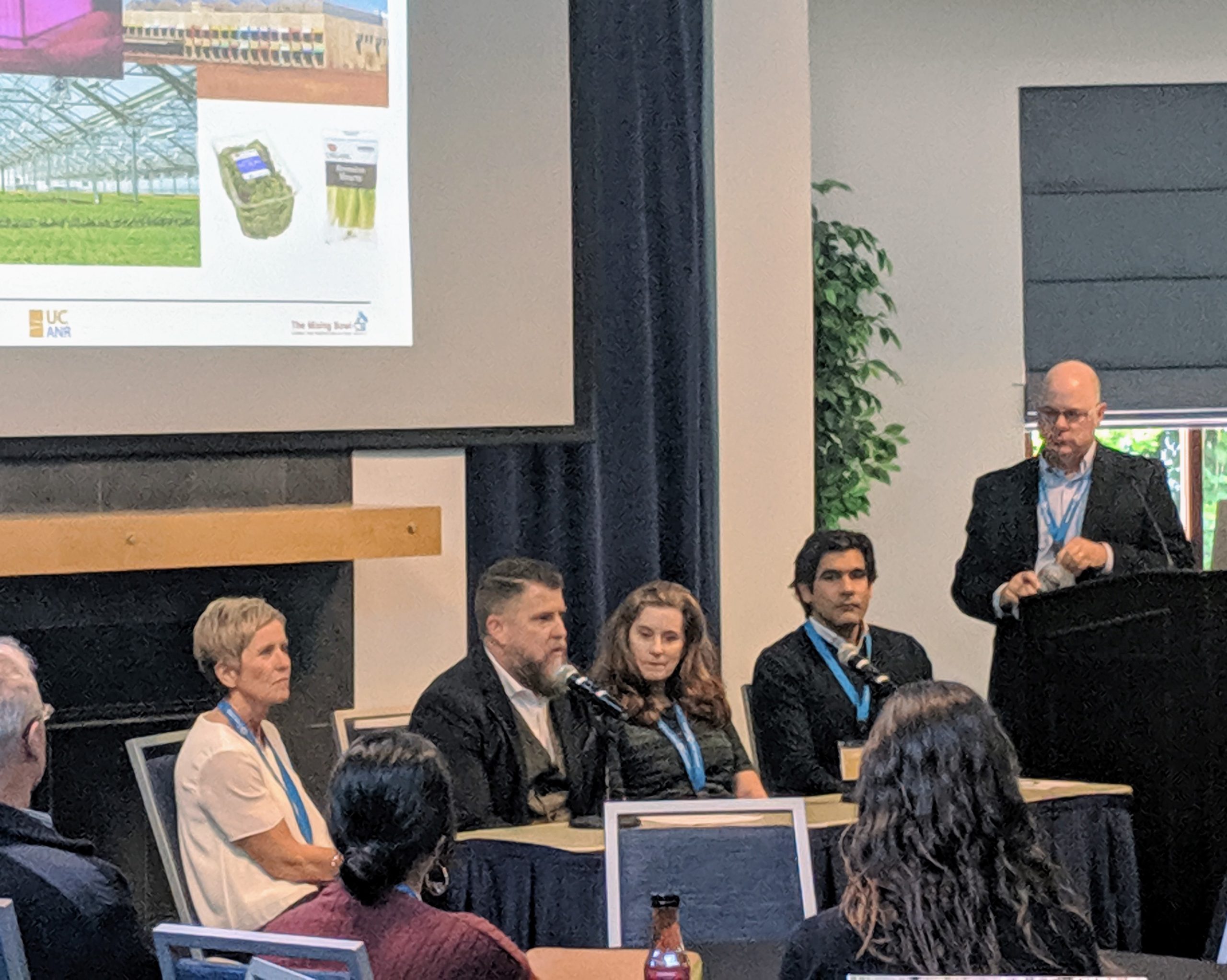Michael Rose of The Mixing Bowl and Better Food Ventures moderated a fascinating discussion on indoor agriculture at the Innovation Institute for Food and Health 2019 Innovator Summit at UC Davis in May.
Rose opened the panel with the impressive statistic that private equity and venture capital had invested nearly $1 billion in controlled environment agriculture (CEA) over the last three years.
He then cited a recent New York City study, which questioned the value of public sector investment in CEA after finding that CEA in the city failed to meet the dual goals of urban agriculture: equitably increasing access to food at a lower environmental cost.
Rose asked the panelists, who represented different points across the CEA value chain, to introduce themselves and respond to this criticism.
Viraj Puri is Co-founder and CEO of Gotham Greens a producer of greenhouse-grown vegetables and herbs. He said that greenhouse farming is not a panacea, nor does it represent “the future of ag.” He noted that there is a false narrative that CEA is trying to solve all problems when what it seeks to do is set up technology to grow certain food crops using fewer inputs with less waste, sustainably, and closer to consumers. He said industry success is not possible without producing a quality product sustainably.
Puri explained that Gotham Greens built its first greenhouse in New York City as a showcase to inspire a global industry around urban farming. With 70 percent of the world population in cities, CEA can bring people closer to food production and provide both learning and employment opportunities.
Silke Hemming, Head of Greenhouse Technology at Wageningen University, first defined CEA as any controlled environment to accelerate plant growth, whether sunless or greenhouse with or without supplemental light; horizontal or vertical; rural or urban and using all sorts of growing methods. She explained that the goal of her research group of about 100 people is solely a technical one – to make CEA sustainable in different climate zones.
Melanie Yelton is Vice President of Research at Lumigrow, a supplier of professional LED grow light solutions including cloud-based software. She said her research is showing the positive impact of LED lighting on product quality and environmental impact. LED lighting can change plant morphology, making CEA produce more nutritious foods and allowing growers to reduce their application of plant growth regulators. She is currently researching how specific spectra can promote nighttime plant growth.
Michael Schutt, Senior Category Manager, Produce/Floral at Raley’s Supermarkets, is responsible for warehouse inventory, orders, and follow-up, including quality and supplier issues. He explained that whether branded ‘greenhouse grown’ at a national, regional or local level, consistent high quality is required to build consumer confidence in and drive sales of CEA-grown produce. Raley’s only self brands where it can provide a better product than the brand names.
Rose next asked the panel to address the issue of autonomous CEA.
Viraj Puri said that fully-autonomous greenhouses may be needed in the future, but the industry is not there technically yet. At the moment, Gotham Greens is in the process of automating their seeding process. But the firm is not a technology company; rather, it is technology agnostic.
Gotham Greens uses Dutch-style greenhouses, sensors and computer control systems plus its skilled growers to achieve specific environmental conditions. It uses supplemental light to achieve even production throughout the year.
Right now, Gotham Greens is collecting enormous amounts of data on plant growth and labor to make informed decisions. They need workers who understand the technology they are using as well as plant physiology.
Silke Hemming noted that although we may never reach fully-autonomous CEA, we need to set our goals high. Greenhouse production is complex – it is very difficult to manage to keep inputs to minimum avoid diseases and other problems. So, having a computerized system available to assess data and control some aspects of a CEA system will help human managers make better-informed decisions.
Finally, Rose asked the panel whether the consumer is willing to pay a premium for CEA-grown produce.
Mike Schutt said that Raley’s experience has been that where consumer awareness and demand for quality and safety converge, the value proposition of the exact production method used becomes less important. For example, Raley’s lowered its price on organic butter lettuce and found that consumers began to buy it over conventional to the extent that it made no sense to continue selling conventionally.
Melanie Yelton wondered whether current consumers will drive the industry, and noted that awareness begins with educating children and remembering who we are trying to feed.
Viraj Puri noted that there is an awareness that we need to eat more plants, but that ultimately, to win over consumers, you need high quality, consistency, and reliability, which are not a given in CEA because “plants are not widgets.”
Silke Hemming noted that in the US right now, the assumption is that the demand for more nutritious produce will drive sales of CEA-grown produce. But, in other parts of the world, especially Asia, the value proposition is food safety. For example, to grow tomatoes in subtropical regions requires a lot of pesticides, so shifting to indoor can mean a more sustainable product with less risk to both farmer and consumer.
This panel makes it clear that the global indoor ag industry is one to watch closely, from both the perspective of new technology as well as consumer demand. If you know of indoor ag innovators that we should be talking to or covering, let us know at hello@vine.press4.pagedesign.us or fill out this quick form.
About the author: Leanna Sweha is an attorney with an agtech background and is Program Director for AgStart. She is passionate about promoting new sustainable agriculture and food companies.

